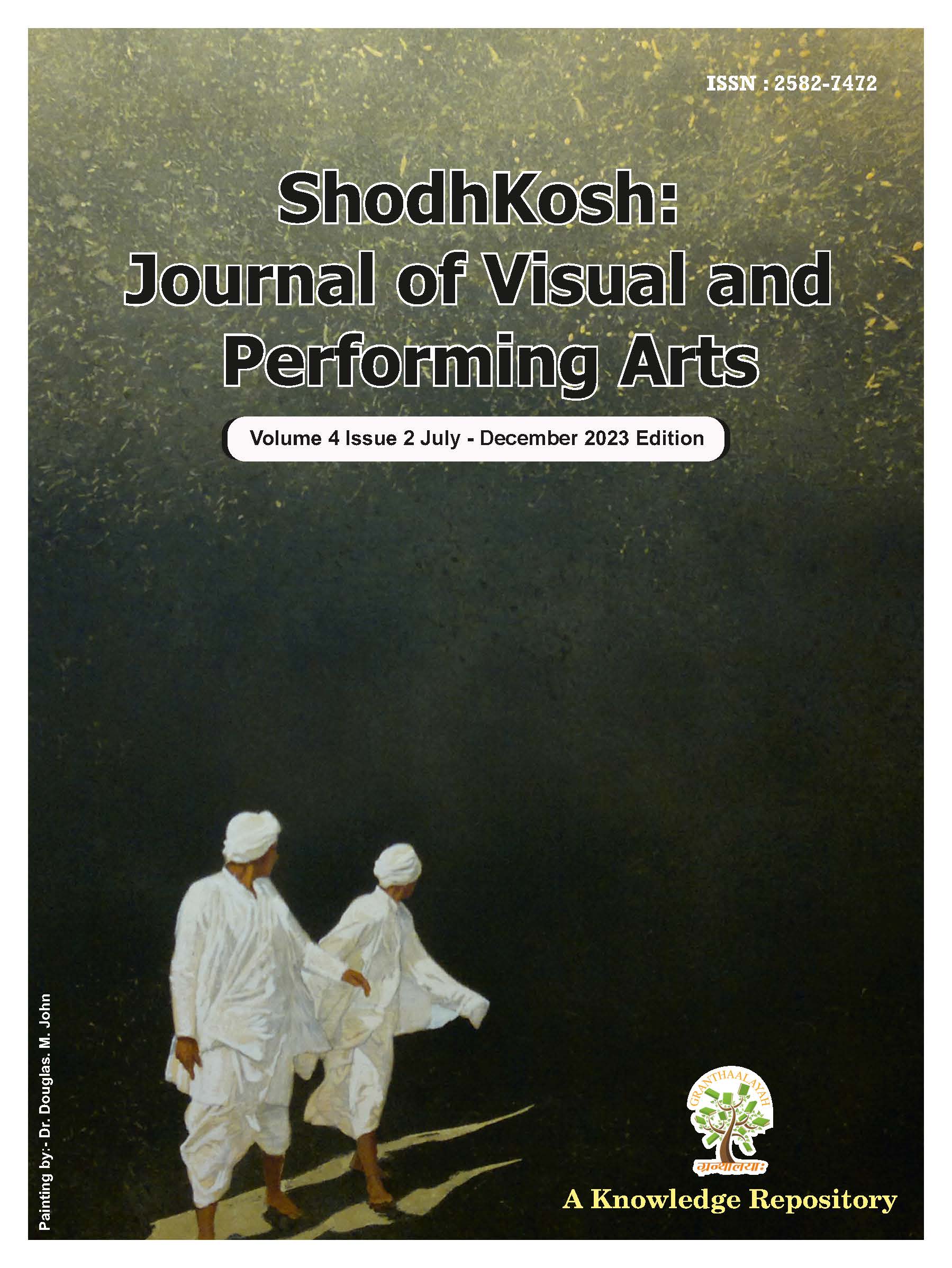MAPPILAPPAATTU AND OPPANA: AN ANTHROPOLOGICAL NOTE ON MAPPILA SONGS AND PERFORMING ART
DOI:
https://doi.org/10.29121/shodhkosh.v4.i2.2023.2376Keywords:
Mappila, Arts, Mappilappaattu, Oppana, CultureAbstract [English]
The Muslim population of Kerala state is known as the Mappilas. The community is formed due to commerce between the Arabians and the Malabarians. Indigenous culture had a significant effect on Mappila's arts and ceremonies. The Mappilas created a distinctive cultural pattern that encompassed a variety of artistic aspects, including their traditional song, Mappilappaattus, and one of the most exquisite performing arts, Oppana. Most scholarly research on Mappilas is historical and ignores anthropological elements like arts and rituals. Thus, this essay aims to offer an anthropological perspective on Mappila songs, known as Mappilappaattu and the performing art of Mappila women, known as Oppana. While examining the nature of Mappilappaattus and its many genres, this research highlights that the secularised Mappilappaattus, which was primarily romantic in substance, drew people from beyond the Mappila community. Oppana also had a secular and romantic tone, which appealed to the public. The popularity of Mappilappaattus and Oppana can be explained, for example, by looking at the history of Malayalam films. Mappilappaattu and Oppana were staples of Malayalam film from the beginning of the 1950s.
References
Aboobacker, K and Abdurahman Mangad. Ed. (2018). Ishal Pootha Malayalam [Melodic Structure of Mappilappaattu]. Malappuram: Grace Educational Association.
Abu, O. (1970). Arabi-Malayala Sahithya Charithram [Literary History of Arabimalayalam]. Kottayam: Sahithya Pravarthaka Sahakarana Sangham.
Adimali, Anshad. (2015). "Mappila Drishya Kalakal Oru Valokanam" [Mappila Visual Arts: An analysis], in Jameel Ahamed (ed.), Kerala Muslim History Conference Proceedings. Kozhikode: Kerala Muslim Heritage Foundation. Pp: 503-507.
Ahamed, K. M. ed., (2006). Mahakavi Moyinkutty Vaidyar Padanagal [Studies on Mahakavi Moyinkutty Vaidyar]. Kondotty: Mahakavi Moyinkutty Vaidyar Mappila Kala Akademy.
Ahammed, A.P. (2014). "Padakalil Padinja Paattu Veeryam" [The Boldness in War Songs], in K.K. Muhammed Abdul Sathar (ed.), Mappila Keezhala Padanangal [Mappila Subaltern Studies]. Kozhikkode: Vachnam Books. Pp: 262-267.
Dale, F. Stephen. (1980). Islamic Society on South Asian Frontier: The Mappilas of Malabar, 1498–1922. New Delhi: Oxford University Press.
Engineeer, Asghar Ali. Ed., (1995). Kerala Muslims: A Historical Perspective. Delhi: Ajanta Publications.
Husain, Sakeer. P. (2018). Cherooor Padappattu. Calicut: IPB Books.
Ilias, M.H. (2007). 'Mappila Muslims and the Cultural Content of Trading Arab Diaspora on the Malabar Coast'. Asian Journal of Social Science. Vol: 35: 434-456. DOI: https://doi.org/10.1163/156853107X240288
Ilias, M.H. and Shamshad Hussain. (2017). Arabi-Malayalam: Linguistic Cultural Traditions of Mappila Muslims of Kerala. New Delhi: Gyan Publishing House.
Jaleel, K.T. (2018). Revisiting Malabar Rebellion 1921. Kozhikode: Lipi Publications.
Karasseri, M.N. (2009). Maapila Kalagalile Anushtanamsam: Mappila Kaladarsanam [The Performing Symbols in Mappila Arts: The Aestheticism of Mappila Arts]) Thrissur: Karala Sahithya Academy.
Karasseri, M.N. (2014). "Badar Pdapppattu" [Badar War Songs], in K.K. Muhammed Abdul Sathar (ed.), Mappila Keezhala Padanangal [Mappila Subaltern Studies]. Kozhikkode: Vachnam Books. Pp: 230-239.
Koppilan, Iqbal. (2008). Vattappattu. Kondotty: Mahakavi Moyinkutty Vaydyar Smaraka centre for Studies and Research on Folk and Mappila Arts.
Kunji, P.K. Muhammed. (1982/2008). Muslingalum Kerala Samskaravum [Muslims and Kerala Culture]. Thrissur: Kerala Sahitya Akademi.
Kutty, V. M. (2007a). Mappilappaattinte Carithra Sancharangal [Historical Waves of Mappilappaattu]. Kozhikode: Lipi Publications.
Kutty, V.M (2007b). Mappilappaattu: Charithravum Varthamanavum [Mappilappaattu: Past and Present]. Thiruvanthapuram: Kerala Bhsha Institute.
Kutty, V.M. (2019). Maalappattukal [Maala Songs]. Kondotty: Mahakavi Moyinkutty Vaidyar Mappila Kala Akademy.
Logan, William. (1887/1951): Malabar Manual. Madras: Government Press.
Miller, Roland. E. (1976). Mappila Muslims of Kerala: A study in Islamic Trends. New Delhi: Orient Longman.
Miller, Roland. E. (2015). Mappila Muslim Culture: How a Historic Muslim Community in India Has Blended Tradition and Modernity. Albany: State University of New York Press. DOI: https://doi.org/10.1515/9781438456027
More, J.B.P. (2013). Keralathile Muslingal: Aavirbavavum Adyakala Charithravum, 700 Ad-1600 AD [Origin and Early History of the Muslims of Kerala, 700 AD-1600 AD, Translated by Shibu Muhammed]. Calicut: Lead Books.
Moulavi, Ahammed C.N. and K.K. Md Abdul Kareem. 1978. Mahathaya Mappila Parambaryam [The Great Traditions of Mappilas]. Calicut: Al Huda.
Muhammed, N.P. (1995). "Reflections on Mappila Heritage", in Asghar Ali Engineeer (ed), Kerala Muslims: A Historical Perspective. Delhi: Ajanta Publications. Pp 35-46.
Nediyanaadu, Hassan. (2012). Mappilapppatinede Verukal Thedi [An inquiry into the routes of Mappilappaattu]. Kozhikode: Vachanam Books.
Panikkar, K.N. (1989). Against Lord and State: Religion and Peasant Uprising in Malabar, 1836–1921. New Delhi: Oxford University Press.
Prange, Sebastian. R. (2018). Monsoon Islam: Trade and Faith on the medieval Malabar Coast. Cambridge: Cambridge University Press. DOI: https://doi.org/10.1017/9781108334860
Puvvakkurussi, Hydros. (2010). Oppana: Charithram, Padanam, avatharanam [Oppana: History, studies and Performance]. Kozhikode: Vachanam Books.
Randathani, Hussain. (2007). Mappila Muslims: A Study on Society and Anti-colonial Struggles. Calicut: Other Books.
Randathani, Hussain. (2018). Mappila Songs and Performing Arts: Genesis and Synthesis. Kondotty: Mahakavi Moyinkutty Vaidyar Mappila Kala Academy.
Sunil, Babu C.T. (2022). 'The Making of the Malayalee Public Sphere and the Exclusion of Mappila Women: Language and Communal Politics in Colonial Malabar', Contributions to Indian Sociology, 56 (2): 133–155. DOI: https://doi.org/10.1177/00699667221132585
Vallikkunnu, Balakrishnan. (2014). Mappilappaatu Vazhakkangal: Charithra Samoohika Pashchathalathil [The Folkstyle of Mappilappaattu in Historical and Social Context]. Kondotty: Malabar Institute for Research and Development.
Vallikkunnu, Balakrishnan. (2018). Mahakavi Moyinkutty Vaidyarude Kavyalokam [The Poetic World of Mahakavi Moyinkutty Vaidyar]. Kozhikode: Vachanam Books.
Vazhippara, Mohammed Shafeeq. (2021). Malabar Samaravum Mappilapppattum [Malabar Revolts and Mappilapppatus]. Calicut: Grace Books.
Wood, Conrad. (1987). The Moplah Rebellion and Its Genesis. New Delhi: People's Publishing House.
Downloads
Published
How to Cite
Issue
Section
License
Copyright (c) 2023 Babu C.T. Sunil

This work is licensed under a Creative Commons Attribution 4.0 International License.
With the licence CC-BY, authors retain the copyright, allowing anyone to download, reuse, re-print, modify, distribute, and/or copy their contribution. The work must be properly attributed to its author.
It is not necessary to ask for further permission from the author or journal board.
This journal provides immediate open access to its content on the principle that making research freely available to the public supports a greater global exchange of knowledge.































